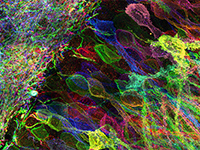The accuracy of expansion microscopy (ExM) depends on the structural preservation of samples embedded in a hydrogel. However, it has been unknown to what extent gel embedding alters the molecular positions of individual labeled sites. Here, we quantified the accuracy of gel embedding by using stochastic optical reconstruction microscopy (STORM) to image DNA origami with well-defined structures. We found that embedding in hydrogels based on polyacrylamide, the most widely used chemistry in ExM, resulted in random displacements of labeled sites with a standard deviation of ~ 16 nm. In contrast, we found that embedding in tetra-gel, a hydrogel that does not depend on free-radical chain-growth polymerization, preserved labeled sites with a standard deviation of less than 5 nm. By combining tetra-gel ExM with STORM, we were able to resolve 11-nm structural features without the loss in accuracy seen with polyacrylamide gels. Our study thus provides direct measurements of the single-molecule distortions resulting from hydrogel embedding, and presents a way to improve super-resolution microscopy through combination with tetra-gel ExM.
